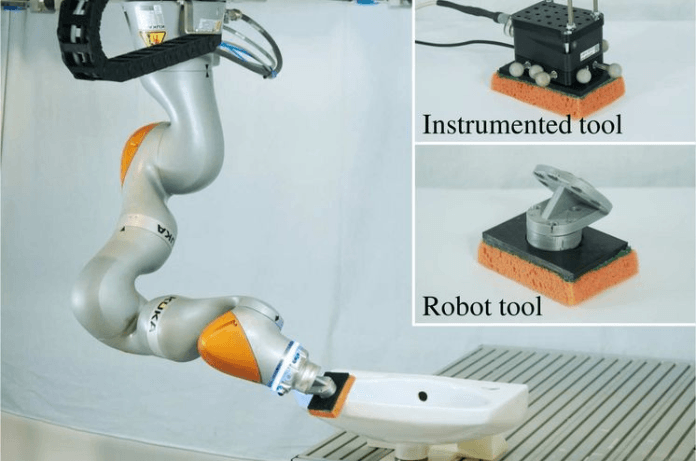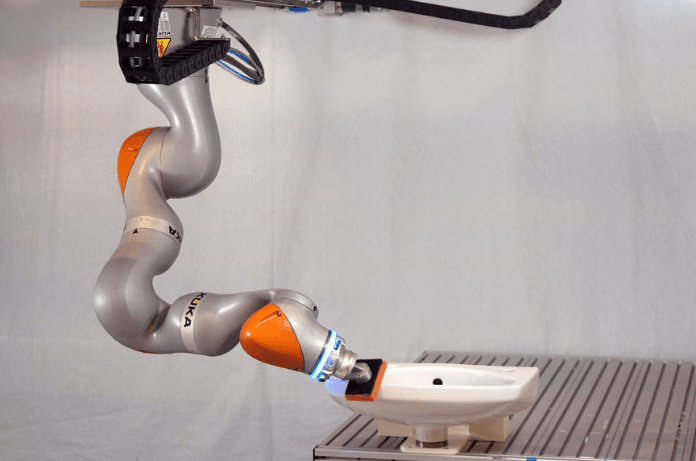Imagine a world where robots tackle those pesky chores you can’t find the time for. Scrubbing the washbasin might not sound glamorous, but researchers in Austria have made significant strides in this direction. Forget, pre-programmed movements their “Learning Robot” grasps by observing, just like a human apprentice!
While robots are meant to free us from tedious tasks, programming them for activities like bathroom cleaning presents a unique challenge. How do you account for every shape, size, and grime level of a washbasin? Writing down every possible scenario with precise movements would be a monumental task.
The Cleaning Sponge Teaches: Learning While Observing
At TU Wien (Vienna University of Technology), scientists took a different approach. They equipped a human with a “specially designed cleaning sponge” but only the front edge – this sponge wasn’t just for scrubbing, but it was loaded with force sensors and tracking markers. This “demo version” was then used to clean just the front edge of a sink, repeatedly.
“We collect a huge amount of data from a bunch of demonstrations, which is then processed. So, that the robot learns what proper cleaning means,” says Christian Hartl-Nesic.

Think of it like showing a new employee the ropes. By observing the human’s movements, the robot learned the essentials of cleaning: how to adjust pressure, hold the sponge at different angles, and adapt for variations in surface shape. This may seem simple, but it’s a complex dance of force, direction, and adaptation.
The Power of Data in Building the Learning Robot
The magic behind this learning process lies in a cutting-edge data processing system developed by the TU Wien team. They combined existing machine-learning techniques to analyze the sensor data from the cleaning sponge. This information then trained a “neural network“, a complex system that mimics the human brain to learn the fundamental movements of proper cleaning.
The result? A robot that can clean not just one edge, but from edge to edge, by just observation data feed of how to clean a small section.
Robots – Peer-to-Peer Learning
This technology extends far beyond sparkling washbasins. Think about these robots sharing their knowledge with other robots. “Let’s imagine many workshops use these self-learning robots to sand or paint surfaces, sand furniture, or weld metal sheets all by learning the basic principles through observation.
All the robots could share the parameters they learned with each other,” says Andreas Kugi
The vision doesn’t stop there. These robots could even share their knowledge with each other! Think of it as a network of robot apprentices, constantly learning and improving. This concept, known as “federated learning,” allows robots to collaborate while keeping private data secure. The robot learns that you have to hold the sponge differently depending on the shape of the surface, that you have to apply a different amount of force on a tightly curved area than on a flat surface,” explains PhD student Christoph Unger from the Industrial Robotics group.
Learning Robot: An Awarded Wining Champion
The TU Wien team presented their work at IROS 2024 – a prestigious conference with over 3,500 submitted scientific papers. A bunch of tests at TU Wien have proven the robot’s flexibility while it cleaned the sink. And TU Wien’s technology schema received the “Best Application Paper Award.” This recognition signifies the groundbreaking nature of this research and this technology is already making waves globally.
The robots might not be ready to take over your entire cleaning routine just yet, but this innovative approach paves the way for a future where robots become valuable assistants, tackling those tedious tasks and freeing us to focus on what truly matters.

